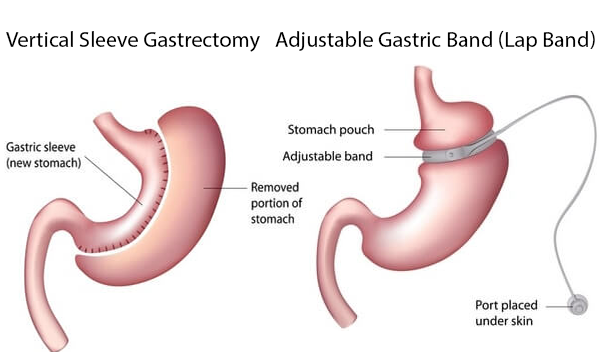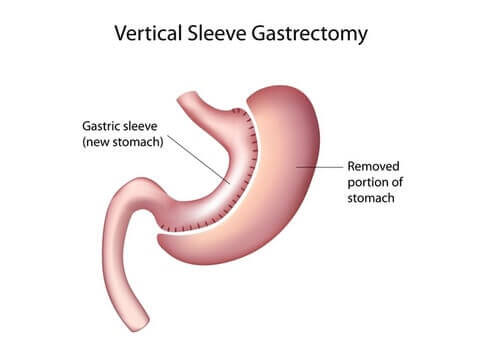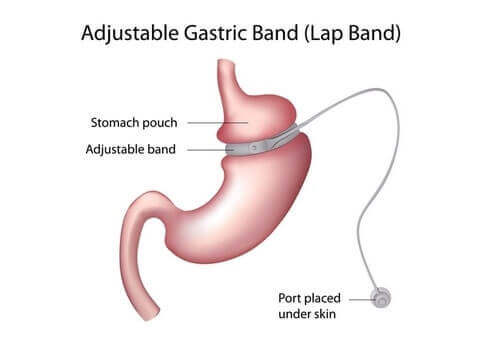The most important takeaways when evaluating gastric sleeve vs LAP-BAND® include:
- How they work: Both make you feel full sooner while eating. Only sleeve makes you feel less hungry. Only LAP-BAND® (i) requires initial and ongoing adjustment by your surgeon and (ii) is reversible.
- Qualify: Same requirements (30+ BMI with health problems, 40+ without)
- Hospital & recovery: LAP-BAND® is a less complicated procedure with a shorter operating time and shorter hospital stay. In-hospital and post-op recovery is similar.
- Weight loss & health improvement: Similar over long-term, but sleeve results in faster weight loss
- Insurance: Same (if your policy covers bariatric surgery, both sleeve and band will be covered)
- Cost: Same with insurance, bypass is about 25% more expensive without insurance.
- Diet & life after: Similar diet and exercise regimen.
- Complications & side effects: Both have a 99.8+% survival rate. Sleeve has a higher risk of short-term complications. Band has a higher risk of long-term complications.

Read the sections below for everything you need to know to decide which procedure is best for you.
TABLE OF CONTENTS
Click on any of the topics below to jump directly to that section
- How They Work
- Weight Loss
- Health Benefits
- Qualify
- Insurance
- Cost Without Insurance
- Recovery
- Diet & Life After
- Downsides
- Summary
- Patient Community & Expert Advice
- Find a Gastric Sleeve or LAP-BAND® Surgeon

SECTION SUMMARY:
- Gastric sleeve surgery makes you feel less hungry & feel full sooner while eating, so you'll eat less and lose weight
- The Lap-Band makes you feel full sooner while eating so you'll eat less and lose weight. Also, it's a "reversible" procedure
Understanding gastric sleeve surgery vs LAP-BAND® surgery starts with the fundamental differences in how each procedure impacts your digestive system:
Gastric Sleeve

Why Gastric Sleeve Works
- Reduced stomach size makes the patient feel full sooner after eating
- Removed portion of the stomach means fewer hunger-causing hormones are secreted, causing patient to feel less hungry generally
How Gastric Sleeve Is Performed
Gastric sleeve surgery, also called the Vertical Sleeve Gastrectomy (VSG), is performed by removing a large portion of the stomach to create a long pouch that connects the esophagus to the small intestine. The pouch is stapled and the rest of the stomach is removed. Some surgeons take an additional step to reinforce the staple line, although whether that is effective is up for debate.
LAP-BAND®

Why LAP-BAND® Surgery Works
- A band wraps around and squeezes a narrow section in the upper-middle part of the stomach. This creates a smaller stomach “section” above the band which fills up quicker after eating, causing the patient to feel full sooner and eat less.
How LAP-BAND® Surgery Is Performed
The LAP-BAND®, also called the gastric band or laparoscopic adjustable gastric band, has been used in Europe since the 90’s but wasn’t approved by the FDA in the States until 2001.
The gastric band surgery procedure involves the sewing of a silicone and Silastic band around the top of the stomach. A balloon around the inner surface of the band (imagine the inside of a bicycle tire) is connected to a tube that leads to a half-dollar-sized port above the abdominal muscles but below the skin.
During follow up visits, your doctor will add or remove saline solution (salt water) to make it tighter or looser. The tighter it is, the less hungry you feel and vice-versa.
The procedure is also fully reversible (unlike gastric sleeve).
SECTION SUMMARY:
- Gastric sleeve vs band: gastric sleeve results in ~18% more weight loss after 2 years
- The amount of weight loss is similar after 5 years
Patients lose weight quickly after both gastric sleeve and LAP-BAND®. However, gastric sleeve patients:
- Tend to lose weight faster
- Tend to reach a lower “low weight” than band patients
- Tend to gain back more weight over the long-term (bringing sleeve weight loss back in-line with LAP-BAND® weight loss by year 5)
The below chart compares average weight loss over time for each procedure:
Example
For for a person who is 5 feet, 7 inches tall and 250 lbs, following is the amount of average expected weight loss for each procedure:
Tap here to expand a table of total expected weight loss for each procedure.
| Timeframe | Gastric Sleeve: Total Expected Weight Loss for 5’7”, 250 lb patient | LAP-BAND®: Total Expected Weight Loss for 5’7”, 250 lb patient |
|---|---|---|
| 3 months | 28 lbs | 18 lbs |
| 6 months | 46 lbs | 28 lbs |
| 1 Year | 64 lbs | 37 lbs |
| 2 Years | 60 lbs | 51 lbs |
| 3 Years | 55 lbs | 51 lbs |
| 5 Years | 51 lbs | 51 lbs |

SECTION SUMMARY:
- The health benefits as a result of having either procedure are similar (details below)
Studies evaluating gastric sleeve vs LAP-BAND® surgery have found very similar health improvement for diabetes, hypertension, sleep apnea, and most other obesity-related health problems, depending on which study is referenced.
Tap here to expand a table comparing the benefits of each procedure.
| Co-morbidity | Gastric Sleeve % Improved /Resolved | Band % Improved /Resolved |
|---|---|---|
| Dyslipidemia hypercholesterolemia | 64% | 70% |
| Diabetes | 55% | 60% |
| Hyperlipidemia (high levels of fat in the blood, high cholesterol) | 35% | 23% |
| High Blood Pressure (hypertension) | 68% | 43% |
| Joint/Bone Disease (osteoarthropathy) | 46% | 81% |
| Depression | Most | 57% |
| Migraines | 40% | Some |
| Pseudotumor cerebri | n/a | Most |
| Cardiovascular Disease | 100% | 73% |
| Venous Stasis Disease | 95% | – |
| Gastroesophageal Reflux Disease (GERD) | 50% | 87% |
| Non-Alcoholic Fatty Liver Disease | n/a | Most |
| Mortality Reduction/ Life Expectancy (5 year mortality) | 89% | 89% |
| Quality of Life Improvements | 93% | Most |
| Metabolic Syndrome | 62% | 78% |
| Polycystic Ovarian Syndrome | Most | 48% |
| Pregnancy | Most | Most |
| Asthma | 90% | 82% |
| Obstructive Sleep Apnea | 62% | 85% |
| Stress Urinary Incontinence | 90% | 82% |
These surgeries can improve joint health. For every pound of weight lost, there is a 4 pound reduction in pressure on the knee joint (9). This improves mobility and reduces pain in the knees.
Both surgeries were part of research on cancer that included over 88,000 participants. Patients who undergo weight loss surgery have 33% less risk of developing cancer (10).
Risk rates were even further reduced for obesity-related cancers, including (11):
- Colon cancer
- Postmenopausal breast cancer
- Endometrial cancer
- Pancreatic cancer
SECTION SUMMARY:
- The BMI requirements are the same for Lap-Band and Gastric Sleeve (details below)
In order to have LAP-BAND® surgery or gastric sleeve surgery, your body mass index (BMI) must fall within one of the following ranges:
- Body mass index 40 or above or
- Body mass index from 35 to 40 as long as you have a serious obesity-related health problem (“comorbidity”) such as diabetes, asthma, hypertension, joint problems, sleep apnea, or one of many others.
- Body mass index from 30 to 35 may be accepted if certain health issues are present

SECTION SUMMARY:
- Both are covered, as long as your policy includes bariatric surgery
As long as your specific insurance policy includes weight loss surgery, both gastric sleeve surgery and LAP-BAND® surgery will be covered
The weight loss surgery insurance approval process can take anywhere from 1 to 12 months, depending on your insurance company and your situation.
Following are the typical steps:
- Confirm with your doctor that your body mass index and health conditions fall within one of the two qualification requirements:
- BMI over 40 –OR–
- BMI over 35 with one or more of the following (insurance companies will usually not cover BMI’s below 35):
- Clinically significant obstructive sleep apnea
- Coronary heart disease
- Medically refractory hypertension
- Type 2 diabetes mellitus
- Other obesity-related health issues
- Complete 3 to 7 consecutive months of a medically supervised diet program, depending on your insurance company (can be coordinated by your bariatric surgeon).
- Schedule a consultation with your bariatric surgeon.
- Schedule a consultation with your primary care physician to obtain a medical clearance letter.
- Schedule a psychiatric evaluation to obtain a mental health clearance letter (usually coordinated by your bariatric surgeon).
- Schedule a nutritional evaluation from a Registered Dietitian (usually coordinated by your bariatric surgeon).
- Send all of the above documentation to your insurance company along with a detailed history of your obesity-related health problems, difficulties, and treatment attempts. The review process typically happens in under one month (usually coordinated by your bariatric surgeon).
- Insurance company sends approval or denial letter:
- If approved, your surgeon’s bariatric coordinator will contact you for scheduling.
- If denied, you can choose to appeal the denial.
Take the Easy Route – Your surgeon’s office will do most of this legwork for you. They are highly experienced in managing the process and may even have all of the required personnel on staff (e.g., registered dietitian, psychiatrist, bariatric coordinator, etc.).
Click here to find a gastric sleeve or LAP-BAND® surgeon near you to get started. Most offices will check your insurance for free to confirm coverage criteria.
For more information about weight loss surgery insurance, see our Bariatric Surgery Insurance Guide.
SECTION SUMMARY:
- The gastric sleeve costs about $19,000
- The Lap-Band costs about $15,000
The cost of surgery should not dictate which procedure you have. You should move forward with the procedure that is most likely to work for you after thorough research and a consultation with your surgeon.
Still, if you don’t have insurance that covers bariatric surgery, there will be a noticeable difference in LAP-BAND® vs gastric sleeve cost:
- Gastric sleeve: Average cost is about $19,000
- LAP-BAND®: Average cost is about $15,000
Surgeons in your area may charge as low as $10,000 for gastric sleeve or $8,000 for LAP-BAND®.
Financing may also be available, depending on your credit. Payments are likely to be around the following if your procedure is financed over 5 years:
- Gastric sleeve: $445/mo
- LAP-BAND®: $334/mo
Visit our Financing Weight Loss Surgery page for all the possible ways to finance your surgery.
Cost of Not Having Surgery vs Cost of Weight Loss Surgery
Even if you’re paying out of pocket, the cost of gastric sleeve and LAP-BAND® is far less than the long-term costs of obesity-related health problems for morbidly obese people who don’t have surgery.
On average, weight loss surgery patients pay off their entire surgery and start getting ahead financially after only 2 years (12).
To illustrate: One study found that bariatric patients pay as much as $900 less per month as soon as 13 months after surgery than similar people who didn’t have surgery (13). Starting in month 13, that’s almost $11,000 saved per year in total medical costs.
Fewer prescription drugs alone have been found to save patients $3,000 or more per year (14).

SECTION SUMMARY:
- It takes 4 - 6 weeks to "fully recovery" from gastric sleeve surgery and the Lap-Band procedure
Recovery from both gastric sleeve surgery and LAP-BAND® surgery includes:
- Timeline: 4 to 6 weeks to full recovery
- Time Off Work: 1 to 3 weeks
- Pain: Same as experienced after any laparoscopic surgery, managed with medication
- Diet: Slow transition from clear liquids to solid foods
- Activity: Slow transition back to regular activity and exercise
However, LAP-BAND® is a simpler procedure to perform and therefore requires a shorter operating time and a shorter hospital stay.
Operating Time:
- Sleeve: 2 hours
- Band: 1 hour or less
Hospital Stay
- Sleeve: 2 to 3 days
- Band: Outpatient (leave hospital same day)
See the following pages for more information about LAP-BAND® vs gastric sleeve recovery:
SECTION SUMMARY:
- You'll have to maintain a very similar diet and exercise regimen for the gastric sleeve or lap-band (details below)
- Gastric sleeve will help you feel less hungry. A Lap-Band will not.
- The Lap-Band requires ongoing adjustments from a doctor
Diet: Gastric Sleeve Vs Band
Your gastric sleeve vs band diet transition is virtually identical:
- 2+ Weeks Before – Practice your post-surgery diet
- 2 Weeks Before – High protein, low sugar, low carbs
- 1 Week Before – Stop or change some medications
- 2 Days Before – Clear liquids only
- Midnight Before Surgery – Nothing to eat or drink
- In Hospital to 7 Days After Surgery (Varies by Surgeon) – Sugar-free clear liquids only
- Day 1 to Week 2 After Surgery (Varies by Surgeon) – Add thicker drinks & smooth foods
- Day 2 to Week 3 After Surgery (Varies by Surgeon) – Slowly test pureed foods & soft solid foods
- Day 3 to Weeks 4+ After Surgery (Varies by Surgeon) – Slowly test solid food
Following are dietary guidelines for both gastric sleeve and LAP-BAND®:
- Test one food at a time to make sure you can tolerate it
- Eat proteins first, in solid form (e.g., not protein shakes)
- Eat healthy “whole” foods
- Avoid processed foods
- Avoid sugary foods or drinks
- Eat slowly and chew thoroughly
- No starchy foods like rice, bread, and pasta
- Avoid any food that is difficult to digest (may be able to tolerate over time), such as:
- Fibrous vegetables like broccoli, celery, and corn
- Nuts
- Seeds
- Skin of any meat
- Tough meats
- Avoid whole milk products
- Drink 64+ oz (2+ liters) of fluids spread throughout the day
- No drinking 30 minutes before or after meals (other than gastric balloon)
- Alcohol only in moderation
Diet issues unique to LAP-BAND® include:
- Unlike the gastric sleeve, the rest of your stomach will still be intact below your band. As a result, drinking water 30 minutes before through 30 minutes after meals will make it even easier to “flush” food through your smaller stomach pouch causing you to eat more than you should.
See the following pages for more information:
Vitamins: Gastric Sleeve Vs LAP-BAND®
Vitamin requirements are usually the same for LAP-BAND® and gastric sleeve, including:
- Daily multivitamin
- 1 to 2 per day, forever
- Chewable or liquid versions are best (instead of tablets)
- Take with food (except dairy) to maximize absorption
- At least 200% of the Recommended Dietary Allowance (RDA) of iron, folic acid, thiamine, copper, selenium and zinc
- Daily calcium supplement, in the form of calcium citrate
- Must be calcium citrate (NOT other forms of calcium)
- 1000-1500 mg. daily, forever
- Chewable and liquid versions are best (instead of tablets)
- Try to find one that includes Vitamin D
- Take 2 hours apart from Iron supplements (or Multivitamin that contains Iron) to maximize absorption
For either procedure, you may be required to take one or more of the following depending on your vitamin levels:
- Folate (folic acid)
- Iron
- Thiamin (Vitamin B1)
- Vitamin D
Exercise: Gastric Sleeve Vs LAP-BAND®
After you’ve fully recovered from surgery (4 to 6 weeks), recommended exercise is the same for both LAP-BAND® and gastric sleeve patients: 2.5 hours per week, spread out over 2 to 4 days.
Following this regimen will cause you to:
- Lose more weight
- Be more physically and mentally healthy
Learn more on our Exercise After Weight Loss Surgery page.
Hunger: LAP-BAND® Vs Sleeve
After gastric sleeve, you are likely to feel less hungry as a result of 80% of your stomach being removed. This is not the case after LAP-BAND® because all of the stomach remains in place.
Here’s why gastric sleeve reduces hunger:
When your stomach is empty, it secretes a hormone called ghrelin into your bloodstream which causes your brain to generate hunger impulses. After you eat, the amount of secreted ghrelin drops then slowly rises until your next meal. Since your stomach will be significantly smaller after gastric sleeve surgery, the amount of ghrelin the stomach secretes – and your resulting feelings of hunger – may also go down.
Food Addiction: Gastric Sleeve Vs LAP-BAND®
Regardless of which procedure you have, food addiction could be a problem.
Our bodies secrete certain hormones, like ghrelin mentioned above, that tell us when we’re hungry and full, but hyperpalatable food (like junk food) may be overriding those hormone signals by overstimulating our reward centers, much like our bodies and brains react to an addictive drug.
You may have a bona fide food addiction if your desire for food takes priority over other parts of your life that you acknowledge to be more important, such as personal health, family, friends, work, your appearance, or avoiding obesity related health issues like hypertension, sleep apnea, or diabetes.
If left unchecked, food addiction can lead to obesity. For weight loss surgery patients, if not addressed prior to surgery, it can also lead to weight regain.
To find out if you may be suffering from food addiction, take our Food Addiction Quiz.
Relationships After Weight Loss
Significant weight loss after any type of bariatric surgery can lead to big changes with everyone around you.
While many of those changes are positive, some can also be extremely challenging and unexpected.
See our Relationships After Weight Loss Surgery page for important changes to prepare for.

SECTION SUMMARY:
- Many of the complications & side effects are the same for gastric sleeve and Lap-Band
- Lap-Band patients have device-related risks and must receive ongoing fills/unfills
- Gastric sleeve patients have higher risk of short-term complications and are more likely to regain weight
Gastric sleeve vs LAP-BAND® challenges are similar, with a few exceptions.
After each procedure:
- Most side effects like nausea, digestive issues, and body changes go away over time or after adjusting diet/lifestyle habits.
- Sagging skin is an issue for some patients, depending how much weight is lost, age, and whether the patient is a smoker
The following challenge is unique to gastric sleeve:
- More likely to encounter short-term complications, since the procedure is more involved
- Weight regain is more likely after sleeve due to the larger sleeve stomach (compared to smaller band pouch)
- See our Gastric Sleeve Complications page for more information
The following challenges are unique to LAP-BAND®:
- Must go back to the surgeon many times in the first year to fill or unfill the band until the proper level of restriction is achieved. As time goes on, patients must continue to visit surgeon occasionally to adjust the fill amount and to shorten the tube connecting the port and band as the patient loses weight.
- Problems related to the band itself are possible, such as band erosion, band intolerance, band leak, or band slippage are not possible with gastric sleeve because there is no gastric band used for sleeve patients
- Problems related to the skin port (where the surgeon inserts a needle into your abdomen to fill and unfill the band to achieve the proper level of “restriction”) are also possible, such as port flip or dislodgement, port leak, port infection, or port dislocation.
- See our LAP-BAND® Problems & Complications page for more details.
Full Gastric Sleeve Vs LAP-BAND® Downsides Comparison
Tap here to expand a table comparing the downsides of each procedure.
| Issue | Sleeve | Band |
|---|---|---|
| Abdominal Discomfort | – | – |
| Abdominal hernia | Yes | Yes |
| Abscess | Yes | Yes |
| Anemia | – | – |
| Band Problems (band erosion, band infection, band intolerance, band leak, band slippage) | – | Up to 18% of patients |
| Depression | Most | 57% |
| Blood Clots | Yes | Yes |
| Body Aches | Yes | Yes |
| Body Feeling Changes | Yes | Yes |
| Bowel Function Changes (diarrhea, constipation, foul-smelling bowel movements and flatulence, difficulty swallowing, gurgling noises) | Yes | Yes |
| Bowel Obstruction | Yes | Yes |
| Deep Vein Thrombosis | Yes | Yes |
| Dehydration | Yes | Yes |
| Dental Problems | – | – |
| Dumping Syndrome | – | – |
| Dyspepsia (Indigestion) | Yes | Yes |
| Esophageal Dilation | Yes | About 14% of patients |
| Esophagitis | Yes | Yes |
| Evisceration & Incisional Hernia | Yes | Yes |
| Food Trapping | – | – |
| Gallstones | Up to 1/3 of bariatric patients | Up to 1/3 of bariatric patients |
| Gastric Fistula | Yes | Yes |
| Gastritis | Yes | Yes |
| Gastroesophageal Reflux Disease (GERD) | About 20% after 1 year; About 3% after three years | Yes |
| Gastrointestinal Leaks | About 2% of patients | – |
| General Anesthesia Complications | Yes | Yes |
| Hair Loss | Yes | Yes |
| Heart Attack | Yes | Yes |
| Hemorrhage (Bleeding) | About 1% of patients | Yes |
| Hiatal Hernia | Yes | Yes |
| Food Trapping | Yes | Yes |
| Hypoglycemia | – | – |
| Infection | Yes | Yes |
| Intolerance to Certain Foods | Yes | Yes |
| Kidney Stones | – | – |
| Marginal Ulcers | Yes | – |
| Nausea, Vomiting and/or Stomach Cramps | Yes | Yes |
| Organ Injury During Surgery | Yes | Yes |
| Peritonitis | Yes | – |
| Pneumonia | Yes | Yes |
| Port Problems (port flip/ inversion or dislodgement, port leak, port infection, port dislocation) | – | About 21% of patients |
| Pouch Dilation | – | Up to 17% of patients |
| Pulmonary Embolism | Yes | Yes |
| Respiratory Failure | Yes | Yes |
| Skin Changes (e.g. acne, dry skin, sagging skin, etc.) | Yes | Yes |
| Stenosis/Stricture | About 1% of patients | – |
| Stoma Obstruction | – | Yes |
| Stroke | Yes | Yes |
| Thrombophlebitis | Yes | Yes |
| Thrush (Yeast Infection) | Yes | Yes |
| Vitamin & Mineral Deficiency / Malnutrition / Malabsorption | Yes | Yes |
| Weight Regain | Yes | Yes |
| Wound Reopening | Yes | Yes |
| Wound Sepsis | Yes | Yes |
For definitions of any issue in the chart, see our Bariatric Surgery Complications page.
SECTION SUMMARY:
- See the "winners" and "losers" by category below
Your individual situation will determine whether LAP-BAND® or gastric sleeve surgery is best for you. Following is a review of which procedure is “better” in each category discussed on this page.
- Most Popular Procedure: Gastric Sleeve
- Most Short-Term Weight Loss: Gastric Sleeve
- Most Long-Term Weight Loss: Tie
- Best Health Improvement Tie
- Easiest to Qualify: Tie
- Low-Cost Procedure (With Insurance): Tie
- Low-Cost Procedure (Without Insurance): LAP-BAND®
- Best Post-Op Diet: Tie
- Fewest Risks & Side Effects: Tie
Discuss each of the pros and cons with your surgeon before making a final decision. Click here to find a weight loss surgeon.

SECTION SUMMARY:
- You can read about the experiences of other gastric sleeve patients
- You Can "Ask the Expert"
If you still have questions about gastric sleeve vs LAP-BAND®, our experts are happy to answer them. We (and other patients) would also love to hear about your experiences.
Please use the form below to share your experience or ask a question.
Questions From Other Visitors*
Click below to see contributions from other visitors to this page.
SECTION SUMMARY:
- You can ask a local bariatric practice for a free insurance check or cost quote
- You can attend a free in-person seminar or an online webinar offered by a local weight loss surgeon
- You should schedule a phone or in-person consultation (both often free), if you are interested in learning more about weight loss surgery



